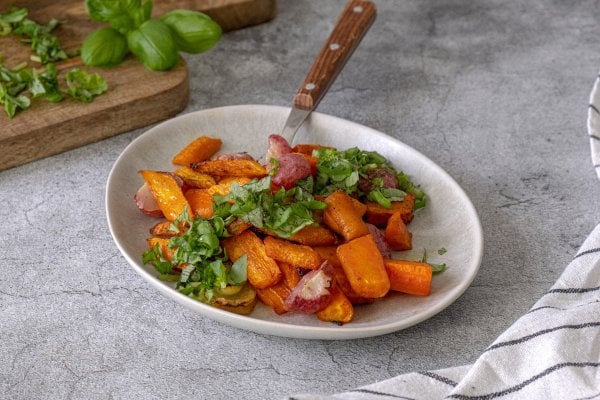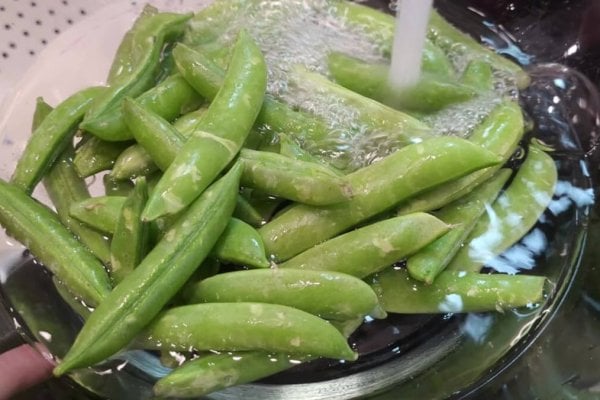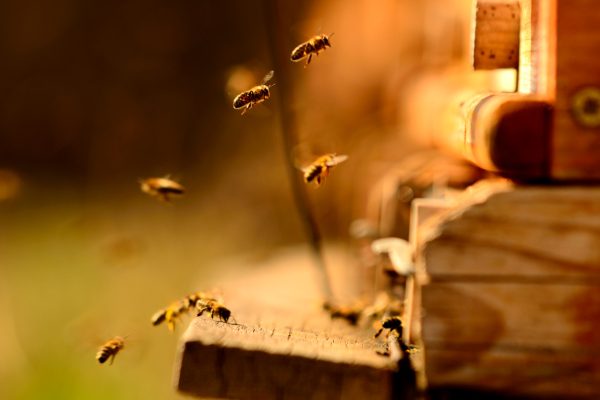
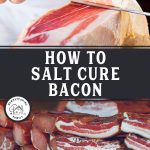
Learn what you need to know about curing bacon at home. We’re teaching you just how simple it is to cure meat, the supplies you need, and answering the most frequently asked questions about cured bacon.
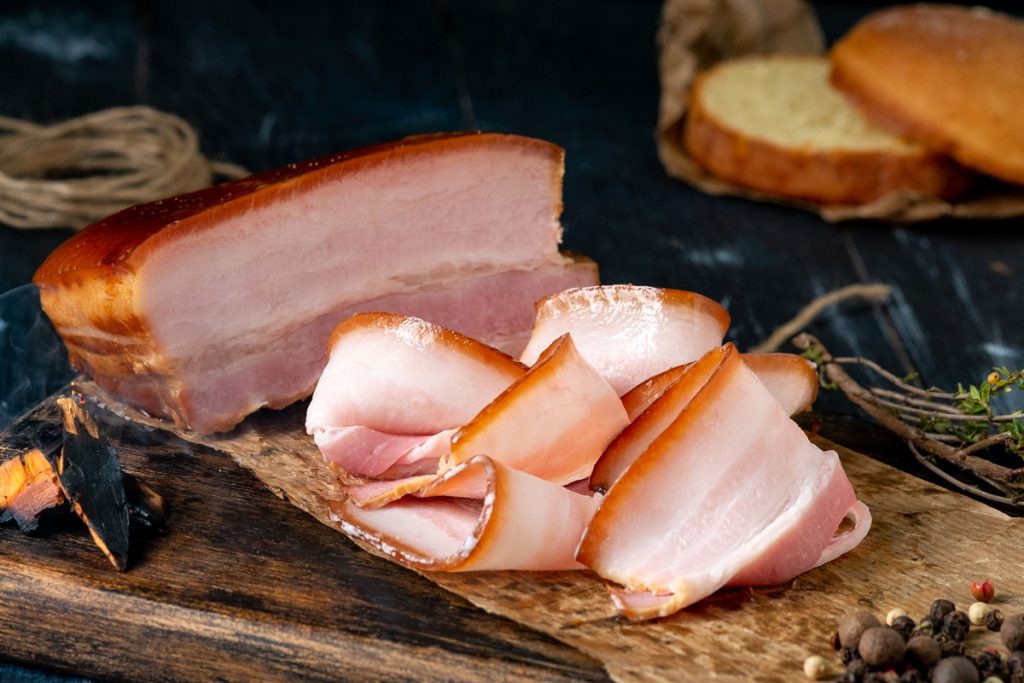
Brandon Sheard from The Farmstead Meatsmith is joining us on the Pantry Chat today. He and his wife Lauren teach in-person meat curing workshops on their homestead in Oklahoma and they also offer online courses.
Brandon taught Carolyn and me how to traditionally salt cure our bacon at home. Traditional eating and consuming whole-food ingredients is important to our health journey.
We’ve been using this method ever since to preserve our pork belly (when we don’t use it to make delicious pork rillette). This bacon served up with sweet pepper hash makes a great breakfast.
Why We Love Cured Bacon
Once you discover the ease of curing meat, how much freezer space it frees up, and how unbelievably delicious it is, you too will be a believer in the process and you’ll never go back to processing pork any other way.
Raising and processing your own meat cuts out so many of the “middlemen”. When we buy bacon at the grocery store, that pork product has gone through so many hands (literally) and so much processing that it’s almost unrecognizable.
Furthermore, the way these products are packaged and shipped wrapped in plastic, which is an anaerobic environment, creates a possible environment for botulism.
Think about when you open a package of sliced ham, the meat itself feels slimy. That’s bacteria!
But if you follow this time-tested process of salt-curing your meat, you can rest assured that your meat is healthy and safe to eat.
Home-Cured Bacon vs. Store-Bought Bacon
The bacon you get at the grocery store is not truly cured. It’s flavored. In fact, one of the things that has to be proved before you can be licensed to sell bacon is that it hasn’t been cured for preservation, but only for flavor.
During the smoking process, the bacon is also cooked and the entire process to make bacon only takes a day or two. This is because of the chemicals used during this process.
Home-cured bacon takes approximately five days because salt takes longer to penetrate and preserve the meat.
How Long Does it Take to Cure Bacon?
There are a few different methods when it comes to curing bacon. As mentioned above it takes approximately five days. However, depending on the size of the cut of meat and the type of salt being used, it can take anywhere from three days to two weeks.
The method Brandon follows takes roughly five days. It’s a simple curing method that’s easy enough to manage while also keeping up with a busy schedule (which is why it works so well for many of us).
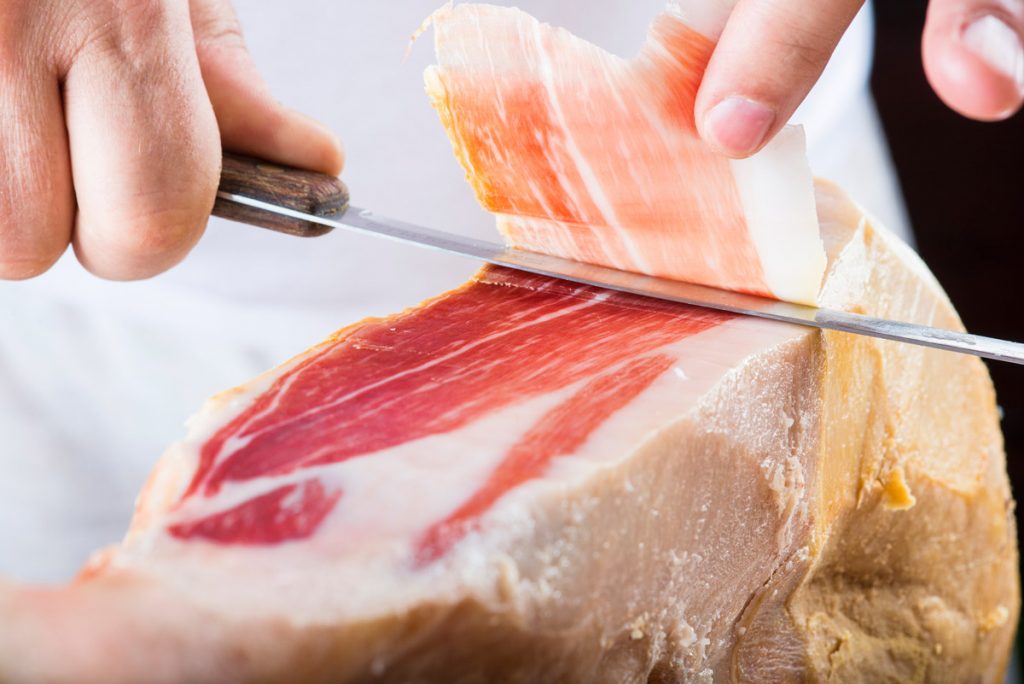
How Long Does Cured Bacon Last?
Properly cured bacon never goes bad. It will continue to develop in flavor and texture over time. But as we like to say, “It doesn’t go bad, it goes different.”
When the bacon first comes out of the salt, it’s going to be at its most tender. This is when the meat is best for frying up at breakfast. It will be closer in consistency to the store-bought bacon we’re all accustomed to.
The longer the bacon hangs and ages, the denser the meat will get. Meat that has been hanging for a long time is fantastic to slice thin and eat raw with some pickled vegetables. We love it served with our fermented ginger carrots, canned pickles, pickled snap peas, or even our quick refrigerator pickles on a charcuterie board.
How do You Store Cured Bacon?
Once the pork belly has gone through the curing process, you can store bacon, hanging, at room temperature. It’s best if it can be stored in an area where it won’t collect a lot of dust.
We prefer using bacon hooks to hang the bacon in the room just off the kitchen where there is plenty of airflow, but out of “direct traffic” areas.
Best Time to Cure Bacon
Traditionally, our great-grandparents utilized the winter months as the months to process pork. For us, we can utilize the refrigerator to give us the freedom to butcher our Kune Kune pigs whenever it fits into our schedule. But the cold temperatures were what was traditionally used for the curing of the pork.
If you live in the north, you can mimic these traditional methods using the cold winter temperatures. When curing meat without a refrigerator, this is the best way to keep the flies away from your meat.
If you don’t have the luxury of cold temperatures, you will want to have a designated refrigerator with enough space to cure your meat between 35-41° F.
Supplies Needed
When you strip away all the extras, all you need to cure bacon is a good healthy pork belly, natural sea salt, and a non-reactive curing vessel. But if you want to get more detailed, here’s a list of supplies you can use:
- Pork belly – we always recommend sourcing your meat from a quality producer or raising your own where you know how the animal has been treated and what it was fed.
- Sea salt – Redmond Real Salt is what we use and Brandon explains that because it’s a mined salt that’s not 100% water-soluble, it will leave a small residue on the pork itself (these are minerals). It’s great to use and makes it harder to over-salt the pork because it has a courser grind. Brandon uses simple fine-grain sea salt. Using a kosher salt is not recommended because it dissolves so quickly that it’s easy to over-salt the pork.
- Curing vessel – For the curing vessels, avoid using aluminum and stick to something that’s either plastic, glass, or stainless steel. For an ideal setup, get a couple of plastic restaurant bussing tubs so that you can drill holes in one that’s stacked in another to catch the liquid that comes off the meat. If your meat is allowed to sit in the liquid that gets pulled out of the meat, it will become overly salty.
- Additional ingredients – Along with the salt, you can add ingredients that will impart flavor to your cured meat. For bacon, Brandon does a 50/50 mixture of salt and sugar. Alternatively, you could add in herbs, seasonings, etc.
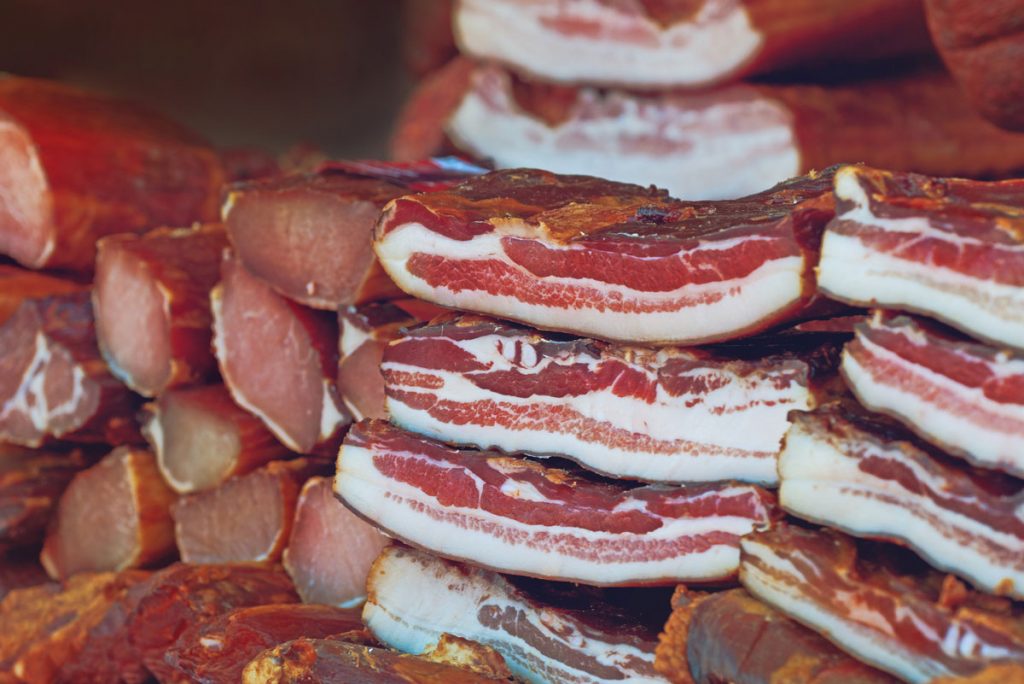
How to Cure Bacon
The basics of learning how to cure bacon are simple. It’s just a matter of patting the meat dry, covering it with salt, allowing the liquids to be extracted, rinsing the meat, drying it thoroughly, then hanging it to either age or until you’re ready to enjoy it.
- Thoroughly rinse and pat dry the pork belly, being sure to trim any flaps of loose meat from your pork belly.
- Create a setup with your curing vessel to allow for liquid to drain out the bottom. Be sure to have a pan or another vessel underneath to catch the liquids.
- Layer a 50/50 mixture of salt and sugar into a large, rimmed container to completely cover the bottom of the vessel, a couple of inches deep, at least.
- Place the pork belly into the salt/sugar mixture and press the meat so it coats all surfaces of the meat. If your pork still has the skin on, there’s no need to salt the skin side, however, if the skin has been removed, flip the pork over and salt all sides.
- Remove pork from the salt/sugar mixture and place it into the clean curing vessel.
- Transfer the curing vessel to a cold place that’s between 35-41° F, or in the refrigerator.
- Let the pork cure for 5 days.
- Rinse off the pork to remove the salt/sugar mixture and rinse well with water.
- Pat the pork belly dry and store it, hanging, in the pantry or kitchen. We like to hang it using bacon hooks.
The most difficult part of learning to cure meat at home is to simply believe the process is as simple as it truly is.
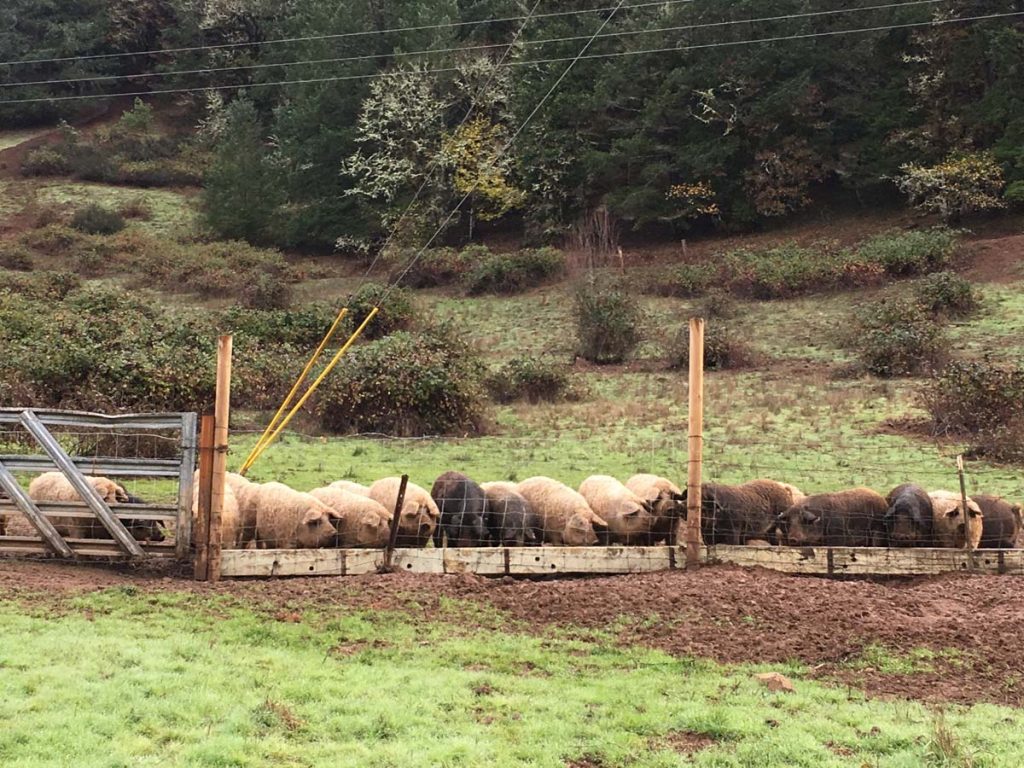
FAQs for Cured Bacon
How to Know When Bacon is Cured?
If you’re doing this for the first time, you may be wondering how to tell when your bacon is fully cured and ready for storage.
Your meat will go from pliable to hard and dense and will no longer bend when picked up from one end. The curing method above is best used on pork belly that is approximately 2-3 inches in thickness. If your pork belly is thicker than that, you will need to cure it longer.
What’s the best meat for curing?
We asked Brandon what is the best cut of meat for beginners. His recommendation is to start with pork belly (bacon) because it’s the fastest.
Pork belly also doesn’t have a lot of contours or cavities that require special attention.
Do You Have to Cook Cured Bacon?
You don’t have to cook cured bacon, you can actually eat it raw. It all boils down to taste and flavor. The longer it’s cured, the more enjoyable it is to slice it thin and eat it raw.
A slab of bacon right off the salt will be more enjoyable when fried or cooked up. Uncooked, it will be rather chewy.
What Happens if I Over-Salt Pork Belly?
Brandon shared that from the thousands of students he’s taught, he’s never seen someone have a cured pork belly that’s gone bad or rancid. What he has seen, and what can commonly take place, is that a pork belly gets over-salted.
This isn’t necessarily a bad thing, it just means you’ll want to use that pork belly in a different way than eating it as bacon.
If your pork belly is too salty, simply cut out the portion of the meat you want to eat (and hang the remaining portion back up for later), then soak that portion in water for about an hour. This will help extract some of the saltiness.
After it has soaked, pat it dry with a clean cloth, slice it up and fry it for breakfast (or however you want to enjoy it).
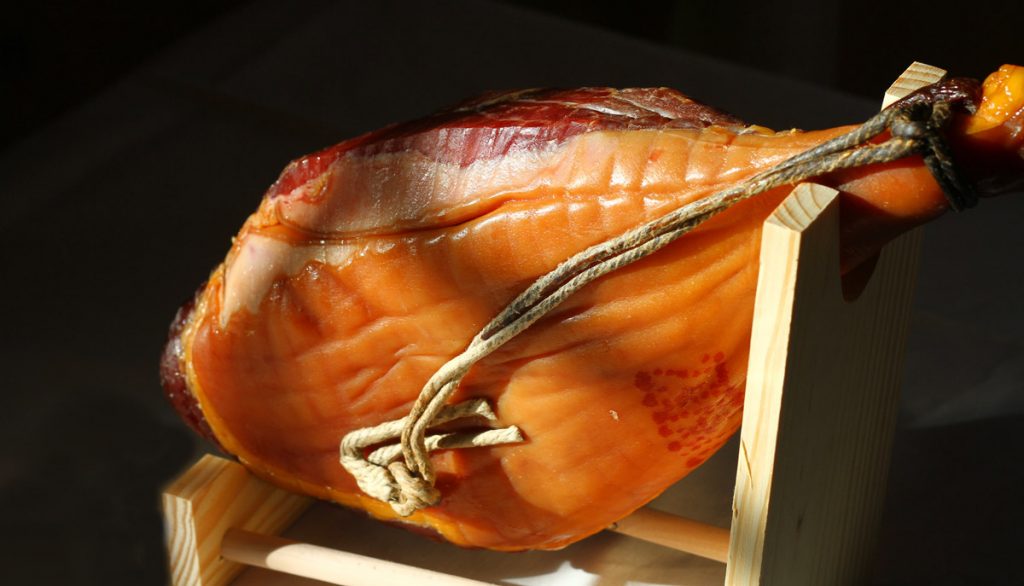
Do You Need Nitrates or Nitrites for Cured Bacon
Brandon shares that nitrites tend to homogenize the product. They give the cured bacon a mildly tangy flavor that we’re all accustomed to.
Nitrates have no effect on cured meat, the nitrates have to be isolated into nitrites first.
Cured bacon that’s cured with only salt will taste different than the cured meats you’re accustomed to from the grocery store.
Nitrates and nitrites are not always the carcinogen that we’ve all been led to believe they are. Brandon shares that using nitrites for curing is more of an exact science as too little or too much does have a huge effect on the safety and flavor of your meat.
For this method, no nitrates or nitrites are needed. There’s no need for concern about botulism when curing a solid slab of meat. If you’re making aged sausages (not breakfast sausage) or salami, there are additional safety measures needed and this method will not be sufficient.
Can You Cure Frozen Pork Belly
Yes! You can cure previously frozen pork belly. Simply allow it to thaw completely before following the step-by-step instructions for curing above.
Bacon vs. Prosciutto
Bacon is made from the pork belly while prosciutto comes from the back leg of a pig.
While bacon is best cured and eaten fairly quickly to maintain that tender consistency, prosciutto is actually best when aged for longer periods of time.
On average, prosciutto is cured for two years whereas bacon can be ready after an average of five days.

Where to Find Brandon
You can learn more from Brandon at the Farmstead Meatsmith to see when their next classes are. They teach the classes in person from their home in Tulsa, Oklahoma.
If you can’t make it to an in-person class, you can sign up for an annual or monthly membership that will take you through the butchering, harvesting, curing, and cooking processes.
More Posts You May Enjoy
- Rendering Lard (or Tallow) for Homestead Cooking
- Pork Rillette Recipe
- Homemade Italian Sausage (Hot or Mild)
- Homemade German Bratwurst Recipe
- Homemade Chinese Dumpling Sausage Recipe
- Homemade Wild Game Sausage Recipe
Josh: Hey you guys, this is Josh, with Homesteading Family. And welcome to this week's episode of the Pantry Chat: Food for Thought. This week, I am honored to have Brandon Sheard, the Farmstead Meatsmith, hanging out with us today.
We've been here in Oklahoma at Brandon's place, filming all week a class with School of Traditional Skills. And Brandon obliged me to come on to the Pantry Chat today so that you guys could get to know him a little bit. And we could talk a little bit about searing meat, something that's near and dear to your heart.
Brandon: Yes, indeed.
Josh: Yeah. But before we do that, we always get into a little bit of chit chat and what's going on. And so Brandon, what is up with you? Outside of this week, we've been working and filming, and on your farm here, what's going on with you and your family lately?
Brandon: Yeah. Well, the big thing is, the learning curve. We are learning our land. We just relocated to a new state. So I'm trying to learn all the understory species, the names of the trees or the grasses, of the kind of pastures out of the soil. So that's actually very enjoyable. But we're bringing on livestock because we're in spring.
Josh: That's right, [inaudible 00:01:12].
Brandon: And the thing about this region is that the grass grows at the speed of light. You can just watch it with the naked eye. It's incredible. So I'm trying to get some grazers on the ground and manage the pasture. So we just got a whole bunch of goslings recently.
Josh: Awesome. Goslings.
Brandon: I think I have 16 out there.
Josh: All right.
Brandon: Yeah. So it's going to be loud, but they're excellent grazers. So I think they're going to help us mow.
Josh: So with beef and sheep, you can generally and a beef, like a beef cow is the standard for measuring how much an animal consumes.
Brandon: Yes.
Josh: And then you can rate sheep against them and right. We're not raising a bunch of goslings, but we have Canadian geese, 20 or 30 of them and I've got some new pasture I'm trying to get going and I'm watching them eat my grass. And maybe you have an answer for this since you're going to actually graze that many. I'm watching them going, how many geese does it take to equal one cow and one cow day out on the pasture. Have you thought what that batch of geese is going to do and how much grass it's going to consume?
Brandon: I haven't calculated it, but the remarkable thing about them is that they do graze and it's almost strange to see a bird graze with a bill, because it seems very inefficient, but they literally do... They like nothing more than to do that all day. They're just sleeping-
Josh: 85% of their diet is [inaudible 00:02:34].
Brandon: Oh my goodness. It's remarkable. And they're very easy on the pasture. There is no scratching like chickens do, there's no massive damage to muddy areas like a cow might do, or ducks will do that too. But they'll drill their beaks and just spread mud, but geese, they're very gentle and all they want to do is eat grass. That's their superpower.
Josh: Wow. And they're fertilizing at the same time.
Brandon: Yes.
Josh: But you don't have a big pile to step into. So that's kind of nice for small holding. You have a method, are you going to move them, rotate them in netting? Is that the plan or a little more free because they're geese and they're smaller. Are you going to do a little more like just kind of free range them with multispecies or something?
Brandon: Yeah. I think for this first run this year, it's going to be more free ranging. They do have a very strong herding instinct, which is kind of nice, which means they stay as a flock. And ducks are very similar and they tend to stay relatively close to home base, especially larger breed geese, which is what these are, they're ended. So they can't fly. They're going to be anchored to the ground, which makes them very easy to contain, even with pretty short fencing. And I think that we're just going to let their flock behavior kind of guide where they go, for the first year and just see how it goes. And I imagine we'll introduce some slightly more permanent fencing within the larger paddocks we have to better manage them.
Josh: So we've got another topic. We're going to talk about curing meat today, but I'm curious because we love geese. We have just one breeding pair. We raise a few every year and we harvest them and love cooking them at special feasts. You're doing it in a much larger scale. So it makes me think about the actual butchering, because geese are kind of tough.
Brandon: Yes.
Josh: So how are you cracking that nut so to speak, because that's going to be a lot to process at once. If you got a method that is efficient, it works well.
Brandon: Yeah, yeah. I find that with geese, because you harvest them when they're so mature, six months old or so, they're fully fledged. And so you're less likely to hit them at that horrible spot when they're right about to molt. And so they're growing new feathers, which is when you get the pin feathers. That's more of a common thing, that's hard to avoid with ducks. And so far with the many, many geese that I've slaughtered, just through my work, I've been able to avoid that pin feather stage. That's just a big part.
Josh: And so that's the big deal right there to make the defeathering job much easier.
Brandon: Yes. And one way to do that is to note, if you see feathers all over your farm yard, don't slaughter the geese yet. That means they're blowing their feathers and they're going to put on new ones and you just want to be sure before you slaughter them that they're fully fledged, that they've got full, nice, long, beautiful, mature flight feathers. And that'll be your best bet at avoiding that pin feather stage.
Josh: Awesome.
Brandon: And I like to keep it simple. I divide the slaughter into two days with geese because the primary yield for me from a goose is it's fat. And so much of that fat is wound up in its viscera, it's a long, its small intestines. And so what I do is I do the keel, the scalding, the plucking on day one. And then I chill them all, in my walk in, or just in a cool spot in the barn and I'll hang them, so there's airflow. And they'll get chilled all the way through with their guts in and everything. And then the next day, I do the evisceration. I actually pull the guts out, by that point, the fat was chilled and it's solid.
Josh: It's a lot easier to work with.
Brandon: And it's way easy to work with. It's cleaner, it's not the big, messy hose job, spraying water everywhere that if its rating is on the kill day. It's actually a cleaner job. You can do it inside. It's kind of nice. So that's how I divide that job up and helps a lot.
Josh: Yeah. Wow. Very cool. Yeah. And the thing I like about geese and why I think it's worth talking about a little bit more here is because for small holdings and people that have smaller areas, I mean, there's a grazing animal that you could be putting to use, that's not too hard to manage and it's got some productivity for you and use up some of that grass, if you're not ready for larger animals, definitely something. Yeah. Very cool. Well, we're going to dive right in. We're talking about curing meat today and Brandon is just the guy to talk to when it comes to curing meat, particularly pork, which is what we're talking about right now. And I know pigs are an integral part of your farm and we are just starting out. We've been raising pigs seasonally for many, many, many years.
But we're just actually going to farrowing and starting our own program. So they're going to become much more of an integral part of our farm. And the goal is to get that to the stage so that we can enjoy the fruit of those labors and also be learning how to cure and store me other ways besides just the freezer, right? And so that's what we're going to talk a little bit about today. And maybe you want to just start off talking a little bit about a few of the different ways of curing, or maybe not even curing, just freezer would be one method. And how you kind of arrived where you're at, doing what you're doing.
Brandon: Yeah, yeah. For us, it was really discovering the simplicity of the process of curing using traditional methods that don't necessitate the use of a freezer. It's so easy and then you pair that with the fact that it is so unarguably delicious, that it's like, you can't go back. Once you see the ease of it and the flavors, it's too good. It's almost too good to be true, except it's true.
Josh: Well, and one of the challenges is that it is so easy that it's almost hard to believe. And we learned the cure baking from you years ago, from some of your early videos. And I remember having those pork bellies in the refrigerator, to get that started and then getting them hung and looking at them and going, really? I can do this? Is this okay? Was that easy and is it really that safe. Do you hear that a lot?
Brandon: Oh, yeah. Yeah, definitely. And I find in the classes that I teach, there's almost this anti-climatic feeling when we get to the curing because it's basically like, here's fresh, healthy pork. Here's some salt, put the salt on the pork, rinse it off and hang it. And you're done. That is the process. And so the thing that is difficult to learn in curing meat is not the memorizing of complex recipes or extravagant methods or measurements or complex apparatus. It's just to believe that it is as simple as it is, because none of the meat that is produced today or that we purchase in a grocery store is even remotely like what you might cure at home. It is unnecessarily complex. And for a good reason, it's dirty, it's transported thousands of miles, it's handled in thousands of environments. So yes. That meat's not going to cure as simply as your good homegrown meat or locally sourced pork. So it's so simple and it does help to have that refrigerator just for that salting stage too.
Josh: Well, and it's one of the neat things about the time that we're in is, we can take advantage of some of the old skills. And bring some of those back and learn some of those that are real benefit, but still using the technology that we have to make that doable. And this is one of those places where we're all trying to do so much, people are trying to work and yet we want to pick up these skills and incorporate them in our lives. And so the refrigerator is a nice place in your method and what you do that allows us to do this traditional skill, so to speak in a modern context. And it makes it doable, it makes it achievable. And I think it just helps our confidence a little bit.
Brandon: Yeah, yeah. It gives you a cool place without insects. So basically what it is, it's what your ancestors would've used winter for, which is winter is the time you kill the pig. That's when you put all the meat on the salt, now you can use a refrigerator to be your out of season, winter time for the curing of your pork. And that does make it a lot easier.
Josh: So we were talking salt curing, which is very, very simple. Can you give us just a basic overlay of what that looks like? I mean, I know we've got different cuts. Now, maybe we want to just take bacon. We all love bacon if we've got pork and just a quick walkthrough, what does it take? How long does it take to get a side of bacon going?
Brandon: Yeah. So if you can start with a healthy pig with the skin on the belly, you're 90% there. You've done the hard work. If it's healthy, it's eaten well and it's been killed. Well, it's been harvested well.
Josh: Yeah. It's so important.
Brandon: Then you have clean meat. You're starting with clean meat. You're not starting with dirty meat that you have to salt excessively just to prevent it from spoilage. You have clean meat, all you need to do is remove some water. So that's the process.
Josh: When you say dirty meat, let's back up a little bit because I don't think you're talking just about meat that got some dirt or dust on it.
Brandon: Yeah. Well, it's a little bit of that.
Josh: It's a little bit of that. You're just [inaudible 00:11:51] just good, harvesting procedure, besides raising the animal and heating them cleanly. So from that, all your feed source, all the way through to just getting it to the table where you're prepping it here. Yeah. Everything's just clean.
Brandon: Yeah. It's a good point. The main thing is definitely the quality of feed. I mean, that's huge. And that definitely gives you a cleaner pig, literally less toxins in it flesh, if it's not in the pig's diet, it's just not going to have it. And that makes it again, easier to cure, but then even supermarket pork is handled so many times and distributed over thousands of miles before it gets to you. So I do think it is literally more dirty and the way that they tend to transport it is wrapped in plastic. So not only is there more bacteria introduced to the surface of the meat, but then they put it in something that's anaerobic in blasting.
Josh: Which is hard in our modern world. We think that's protecting it, right? And maybe in that context, it is, because it is changing hands so much. It probably that plastic probably is protecting it. But it's also damaging it as far as keeping at me clean pure.
Brandon: Exactly.
Josh: Because what does that anaerobic environment do?
Brandon: Yeah. That creates the possible conditions for botulism, for the creation of that Clostridium botulinum bacteria to proliferate and release that spore in an anaerobic environment. Now, it's very puritanically kept in very low temperatures. The whole time is transported. But even then, when you get that meat or even when a butcher gets it at a grocery store and you open up that bag, the meat is slimy. It has a surface slime growing on.
Josh: I remember that opening packs of bacon when I was a kid. I never thought of it much then, now, and that's what comes to mind when you say that. So I remember those packages, I would make ham sandwiches as a kid. And I remember that.
Brandon: That is bacteria. That is bacteria colonizing the surface. And I have the luxury of raising my own pigs and butchering them, you'll notice, even the pork we worked with this week, it's dry. The skin is dry. It's not leaving puddles of water or slime on the table as we work with it. And that's just because it's cleaner.
Josh: Yeah. Wow. So let's talk about that commercial pork for a minute. And searing because is that really cured? What we're getting, at what they're calling ham or what we're getting at the store, is it really cured?
Brandon: No, it's been flavored. So when they cure bacon or ham today and they sell it at the grocery store, one of the things actually that they have to prove before they can be licensed to sell it is that it is not cured for preservation, but only for flavoring. And that's just the way the industry is.
Josh: So we're getting ripped off of a bit even.
Brandon: Yeah.
Josh: We're really getting sold something that isn't what it is.
Brandon: Yeah. It's not cured. Even if you bought slab bacon at the grocery store and unwrapped it and tried to hang it in your kitchen, it would probably go off because most of bacon is cooked. It's pre-cooked when you get it. And in the smoking process, they cook it. And even before that, it takes the factory just a day or two to cure bacon, to make bacon. And that's because they're using nitric or synthetic cure ingredients that actually pass through the meat faster than salt does. Salt actually takes a while to equalize throughout the meat. Whereas, these synthetic ingredients, they pass through within hours and they do it in refrigeration temperatures.
Josh: Yeah.
Brandon: And that's what so appealing to the industrial production of meat.
Josh: One of the things that's amazing to me about this is you can go and buy this meat from the store that's supposedly been taken care of in this industrial method. It's safe and it's good and it's clean and you leave it out and it's going to go bad. You can take what you do and what we do. And many of us are doing with curing salt and take your raw meat, cure it with salt and leave it out. And it goes good, as you said, many times this week, I love that phrase. It really goes good. So tell us a little bit about then curing salt and just some of the basics of it and what's happening there. Why is that? Why is it so simple and what's happening that's making that work when you're just taking a good cut of meat, say pork belly and salt. How does that come together and make this product, it doesn't go bad, it goes good.
Brandon: Yeah. And really the simplicity comes from the fact that the function of the salt that is curing to meat is simple. It's just removing and binding water. That's all it is. It's not any more complex than that. It's not a ferment. We're not trying to nurture beneficial bacteria. So it out-competes the bad stuff and produces acid and lowers the pH. That's a more complex thing. That's salami, which is wonderful, but that is a little more sensitive as far as the aging climate in which it's hanging, whereas bacon, prosciutto, whole muscle cures that aren't ground, but just a slab of meat. You just need to dry those out with the aid of salt. And that's all it's doing, because if that meat is going to spoil, it's going to be because of free water, so just puddled available water. That is where bacteria can get in and proliferate.
Josh: So the curing of meat is really just the removal of the water, that's all we're doing. We're just using the salt to remove the water and that preserves it to where you can leave it up there. And what we'll talk a little bit more about that in a minute for indefinitely, more or less, the product changes. So, very cool. Well, let's talk about how long it takes to cure bacon? From start, you've got your pork belly and you got some salt, how long does it take to get a usable product? And maybe, let's talk about bacon and then prosciutto, which is ham, which I just learned. Prosciutto.
Brandon: Prosciutto.
Josh: Prosciutto, sorry. Yeah. Is really a Latino, an Italian for me. Yeah. So how long does it take to get bacon?
Brandon: So I'm going to say five days because that's one way to do it, but honestly, you could do it in three days or two weeks. This is the funny thing that it's so flexible and simple, that a lot of these times, they're not hard and fast recipes, the recipe or the method that I follow. It's five days more just out of simplicity, it's something that I can manage in the middle of a busy family life and an active farm and running a business and everything. But really, if you were to put a couple handfuls of salt on pork belly and put it in your fridge for about three days and then take it out, rinse it off and dry it and hang it, that would cure, that would cure the belly.
Josh: And when you say dry, you're literally just patted dry. You're not doing anything special, not setting the sun, dehydrated or you're just-
Brandon: Pat it dry with towels, after you've rinsed off any salt that remains. So in its bare simplest form, that will work. And then really the only subtlety or the craft or the refinements that you might make to that process, those come in when you're trying not to over salt. And you're trying to remove just enough water with the salt to allow the bacon to go good but no more. You're salting it just to the minimum, just to what's necessary because if you do that, then the bacon or anything that you hang will ripen and actually get better and develop more complex flavors with time.
Josh: That's going good.
Brandon: Yeah. That's going good.
Josh: What's really interesting is, when you do this for the first time, most people are worried about going bad, right?
Brandon: Yes.
Josh: And what's amazing is, really the only way you can do this wrong is to over salt it, right?
Brandon: Right. Yeah. I mean, that's the most common mistake. In fact, I have to say, after teaching thousand of students, hundreds of classes, I've never gotten a report of a spoiled belly. I've never lost a belly to spoilage. I've cured hundreds and hundreds of pounds of bellies. What I have done and what others have done is oversalt the belly, which is not a bad thing. That's not the end of the world. That just means you have a belly that tastes a little more salty.
Josh: And so you're going to use it different, right?
Brandon: Exactly.
Josh: Do something different. And you can even maybe talk about that for a second. You can reduce that. You can extract some of the salt.
Brandon: Yeah, yeah. It's not a bad idea if you have a belly that's just too salty to the taste. You can cut off a chunk that you want to eat and just soak it in water. And if you give it an hour of soak, it's going to pull salt out, then you can slice and fry that up for breakfast and just hang what remains back up.
Josh: Wow. So how long can you store and say, eat off a slab of bacon?
Brandon: Until the end of the world or you eat it, whichever comes first.
Josh: That's my kind of preferation right there.
Brandon: Yeah. It really never goes bad. And I should say, it will develop over time. So when it just comes off of salt, it's going to be very tender. It's still going to have some moisture to it, which is nice. And that is kind of the ideal texture for breakfast meat. That's how we usually think of it. You slice it and you fry it up for breakfast, but then the longer it hangs, it gets more dense. And when it's really dense and really dry, it's actually more pleasurable and enjoyable just to slice it real thin and eat it raw, maybe with some pickled vegetables, because it'll be rich and fatty and delicious. So it's very flexible that way.
Josh: So now, how about prosciutto? And let's talk about that because the bacon, usually, you're rarely going to hang it as long as you can because you're going to consume it. But you can put up a lot of bacon, hang it and you've got a very simple, low technology stored meat, which is really cool. But a prosciutto is something that can be stored longer term. And actually you don't want to use it until longer term. So tell us a little bit about prosciutto.
Brandon: Yeah, yeah. Prosciutto is the back leg of a pig and every country in Europe has their version of it. It's the back leg of a pig that's been cured and you want it to hang for a long time because that's how it ripens. It develops particular flavors. So in general, and again, you'll find exceptions all over the board because there are more ways to do this than not to do it. But in general, two years is about the minimum hanging time for a prosciutto, which is why this is such a thrifty way to consume pork because it'll take you a little bit to go through the bacon. And by the time you've gone out of that, hey, your [inaudible 00:22:27] is ready to go, and that's the jowl and you would cure that right with the bacon. And then by the time you get to that-
Josh: Same item, is that salt cure?
Brandon: Salt cure. I mean, in the same cup, the exact same way. And then maybe you've got the culpas, the shoulders and then those are ready to go and you get through those. And then you can get to even the two year mark and now it's time to cut into the prosciutto. So it's literally the most thrifty and extravagant way to consume pork.
Josh: That's one of the things I think is really neat that I learned this weekend. It's really know that about prosciutto and how you can take this whole leg and cure it. We think of this as this fancy meat. And I mean, it is, it comes extravagant and the taste is so rich and beautiful. You don't need to eat a whole lot of it, but talk about a simple, quick way to preserve a lot of meat, in a leg like that, to me, that's just beautiful. And so what you're describing is you can pretty much cure just about a whole animal with this simple traditional method.
Brandon: Yeah. And that's what they used to do. You can even find in Britain, up in the Highlands where there are stone homes and the beam over the door, it's all stone, it's completely stone. And engraved over the door is 1623, the date of the building, so that structure. It's those buildings with the stone shingles as the roof. It's incredible. Yeah. Yes. And you'll find in one particular room, a trough with drains gouged out on the side. And that is literally built into the structure of the building. That's the baking hearing trough. And it's the size of a pig.
Josh: Okay. So the drains for the moisture so you put your salt down in there, but so you could put a... Was that made to put a whole pig in?
Brandon: It's made to put a whole pig, cut in half, so by side, they would still do one side at a time. Yeah.
Josh: Wow. It is amazing to me, just how simple some of these things are and kind of how duke we almost are in trusting our technology... Trust in our science is the word today, right?
Brandon: Yeah, yeah.
Josh: And yeah, you buy store bought meat, it's going to go bad on you if you leave it out. And raw milk, it's the same way, milk, you buy the store bought milk, you leave that out and it's dangerous. But yet you can get milk the way God gave it to you and leave it out. And the flavor's going to change. The texture's going to change, but it's still usable and even good. And so we can take a whole pig and just little bit of what God gave us and salt and take care of that and preserve it and it goes good, it goes wonderful, it goes better.
Brandon: Yeah. And I think we're wired to detect if it goes bad too.
Josh: Well, and that's one of the common threads with raw mill, with fermenting vegetables, hearing you talk this week about curing the pork and how to know, we're all people, we're all worried about because it's going to go bad on, how do I know? And I know Carolyn says the same thing you've been saying all week. And we were doing a fermenting class with Lisa Bass, about fermentation. She was saying the same thing. God, we know if it's going bad. Now, it may go different. It may be something you're not used to, it may be too strong, or different things like that, you've got to learn how to enjoy or that might be challenging, but it doesn't go bad. Something that goes bad, you're going to know it. And you were just saying, we're made to know that.
Brandon: Yeah. You're not going to be guessing. That's a great confidence builder when it comes to curing meat, because it means you're not going to accidentally eat something that's going to make you sick when it comes to whole muscle cures. Salami's different. It's theoretically possible there for a toxin to be released that you can't see or taste or smell.
Josh: Well, it's a different process. You've a lot more surface areas, opportunity for moisture. And different things going on there.
Brandon: Yeah. But with the whole muscles, when they go bad, they go obviously bad. Nobody doubts that it's gone on.
Josh: You don't have to worry about it. So can you, should you cook cured meats, cure pork, just leaving in that realm right now, do you need to cook them or I guess the bigger question is, can you make them wrong?
Brandon: Yes. Yeah. You can. And the way we do it is, it's very much a matter of taste, the longer any cured meat you hang, whether it's bacon or prosciutto or blanquette, or lo Moloso, the longer it hangs, the more dry and dense it becomes. And when it's that dry and dense, almost like wood, it can be really hard. It's more pleasant and enjoyable to do thin shaves. And serve it with cheese or something and nice homemade bread. And you just eat it raw that way. Technically, you could eat it raw right off the salt, right after you've cured it, if you're starting with a healthy pig and that's fine. It just might be a little chewy, especially with a belly, it's going to be less pleasant than frying it up, which is really when it's good. Fresh, just off the salt.
Josh: That's part of the fun and part of the art of it with the cure too. And what I'm seeing and learning is that, you can find where you enjoy it most, or learn to enjoy it throughout its different stages.
Brandon: Exactly.
Josh: We're so monocultural today, we just want one thing to taste this way, instead of like, you can take that bacon or this prosciutto right behind you and learn that you're going to have a different almost relationship with it, on a pallet over seasons, over time. And that, I don't know, that makes the experience that much more fun.
Brandon: Yeah, absolutely.
Josh: So I got to ask this question and I pretty kind of much answered it, but is there a place for nitrates and nitrites and all of this? Why and why or why not?
Brandon: Yeah. The only reason I don't use them is because they tend to homogenize the product. They tend to lend it a pink color and a very product, typical mildly tangy flavor, that we all recognize. That is the flavor we have come to associate with cured meats. When you cure meat with salt in your home and you taste it for the first time, you're going to be a little surprised like, whoa, this is very different.
Josh: Yeah. It's got flavor.
Brandon: Then what I saw cured meat tastes like. And that's because we're used to the flavor that nitrite gives the cure meat, which is mildly tangy. And it's not necessarily a carcinogen unless you... Which it kind of has a reputation, the-
Josh: That discussion's gotten overblown and Carolyn and I studying, we used to think that was a big deal, big issue. I mean, people have been using, I forget which one comes first, is it the nitrite? Then they go down, is it the other way or around?
Brandon: It's nitrate reduces to nitrite.
Josh: To nitrites, but I mean, [inaudible 00:29:02], they use [inaudible 00:29:02], right? For nitrates, to preserve and people have been using these for a long time, since there is a traditional use of them.
Brandon: That's right. And it's in the form of saltpeter. And usually it's mine, there are mines in Bolivia, it's veins. You can see them in cave walls and they mine it. And that is potassium nitrate, which still has to be nursed into nitrite to even have an effect on the meat at all. Nitrate does nothing to me, has to be reduced to nitrite.
Josh: So it's a more complex process.
Brandon: Yes.
Josh: As far as for the Homesteader, the person wanting to apply this just simple curing method, it's not so much that these nitrites and nitrates are bad, they can be used. And that's a different discussion. And we'd agree that, that discussion's overblown the fear of that. But it's a more complex process, maybe a little harder to attain to where salting is just a lot easier to get going.
Brandon: It's a lot easier. It's a lot simpler primarily because potassium nitrate, or if you purchase already isolated nitrite, you have to use them at the very closely prescribed levels because they are so volatile. The problem with those is you don't want to overuse them.
Josh: So it's not as forgiving?
Brandon: It's not as forgiving at all. You got to follow a very close recipe and you got to follow it very closely so that you don't over-nitrite it, because that is very dangerous.
Josh: Okay. So supplies needed, what does somebody need to get started?
Brandon: Yeah. And I know I'm like a broken record, but if you just start with good pork, 99% of your problems, that you might encounter, they're solved, before you even get the salt out. So just healthy pig, locally sourced, ideally. Just keep it clean. So that's always number one, but then, for curing meat at the most basic level, you just need some natural sea salt. So I prefer, you can even use mine salts, like Redmond salt will work. The mine salts have lots of other minerals in them, which add flavor and they're great, but some of them aren't soluble. So they might leave a little mineral dust on your [inaudible 00:31:09].
Josh: And that's what we do, that explains something because that's what we use. We use a lot of Redmond salt. We buy in bulk and have a lot of it for everything. And we have definitely seen that it wasn't, I remember first seeing it, it shouldn't be moldy. It definitely shouldn't be moldy already. We just had that little dusting on it. And so that explains that.
Brandon: Yeah. And it's not a problem at all. It's a less salty salt, so it's kind of a good hedge against over-salting. It's a good salt to use and just, natural sea salt. So I avoid kosher salt because it is a manufactured salt and it's not a flavor from salt. It doesn't taste very good. It's just solid, what is it? Sodium chloride.
Josh: Sodium chloride. It's just pretty pure sodium chloride.
Brandon: Exactly. Totally [inaudible 00:31:57]. So it's very salty. And the flake shape makes it dissolve very quickly. So it is easy to oversalt with kosher salt. So I have simple, fine grain, sea salt, I think is the way to go.
Josh: Very cool. Okay. So good pork, salt.
Brandon: Good pork and salt.
Josh: What else do we need to get started?
Brandon: It would be good to have curing vessels that are non reactive. So this is the container that you're going to put the meat and the salt in and you just basically go on it to be aluminum. So it could be plastic. It could be wood, it could be parson, it could be glass. I prefer to use plastic honestly, because I can drain it. I can have a self draining tub, which is another way you can help yourself to not oversalt because if the meat's sitting in its own liquid that it's pulling out, it's going to get over-salted. And so if it has holes in the bottom of the tub and that tub is nested in a solid tub, then it will drain away from the meat, which works perfectly.
Josh: And so the bath tubs that you can get at a restaurant supply, you can order them online, Amazon, those things are ideal. They fit on a shelf in your fridge. They'll generally hold an average size leg, right? Or several bellies. And you can easily drill some holes in them and stack two together. So one drains, one catches. That's just the kind of Homesteader go to.
Brandon: Yeah. It works really well. And then if you live in the north, you can use the winter as your time to cure, because there's not a lot of flies, cool even temperature, but then you can also get yourself a spare curing fridge. And this is not a fridge that's temperature and humidity controlled in any fancy fashion. Just a spare fridge. Yeah, that's just chilled, 35 to 41 kind of going around in that zone, Fahrenheit. And that's where you will salt the meat, during that fragile initial stage, you want it to be in a fly free environment. And that's what that fridge tends to do.
Josh: For bacon, how long are you going to leave it in that cool environment before you can take it out and hang it up in your kitchen or your pantry?
Brandon: Yeah. The recipe I like to follow is just five days.
Josh: Yeah. That does it. That does enough. That pulls the moisture, pulls enough moisture out, that you can then take it out of that cool environment and put it into room temperature.
Brandon: Room temperature. Ambient temperatures in your house.
Josh: So you can get by even your own fridge, if you can clear it out a little bit. Did you get started and you have one pig and you want to do a few bellies, you could get by, the five days in the fridge, take it out and then you can hang it.
Brandon: Once it dry, you can hang it.
Josh: Let it cure.
Brandon: Yeah. And even the duration that it's in the fridge is very flexible. Really it just needs to have sufficient quantity of salt, pull out a sufficient amount of water. Sometimes that can happen in 30 hours. It's done, it's very quick. So if it's fine salt, it'll happen that much quicker than if it is kosher salt.
Josh: It's mind blowing how simple this is. The first time we did it, I remember just stressing over, is there enough salt? Is there too much salt? Have we left it in the refrigerator long enough? And should we flip it? Shouldn't we do this and that. And the more I learned, the more I realized just, no, you just have to be confident in the simplicity of it and what you're saying and what you're teaching and it just works. Yeah. Let's see, what's the best cut of meat to get started? I mean, is it the pork belly? Is that the easiest part to start with?
Brandon: I would have to say it's pork belly. Yeah, yeah. That would be the simplest because it's quick and it doesn't have lots of contours or tricky cavities and it's a quick turnaround. You pretty much within a week get the most delicious bacon you've ever tasted.
Josh: Well, best thing to do is either raise your own pig or go buy one from a local farmer. And maybe even have them cut it all up and have them save you a half of a belly or something. If you're jittery, you're like, wow, that sounds cool. But I don't know. And just get started and try it out.
Brandon: Yeah. And even if it's frozen, even if you get your half pig back and you that half belly winds up in the freezer, because bacon is not preserved through fermentation, we don't need there to be bacteria on the meat, which would kind of be taken out by the freezer, if it's in there long enough. It's just dry. So you can actually thaw out that belly and cure it and it'll work.
Josh: Right on. So how do people learn more? Tell them about what you do. And how they can learn more. I know for us, even we try a lot of things and we had heard all this and needed to come to you six, seven years ago to find out more, to get some confidence. Yeah. What do you do and how can you help everybody out?
Brandon: Yeah. I think that the most direct way is to go to farmsteadmeatsmith.com. And you can look at our upcoming classes because we teach this in person here in the middle of the country in Oklahoma. And we go through the whole process. And you can actually fit the whole narrative in your brain. It's not complex. And we teach curing, very simply and then you can also look at, we have an online option. We have the Meatsmith Membership and you can sign up annually or monthly. And it's got an archive of over 50 videos, including how to cure meat, but also how to harvest everything, all livestock and butcher and cure it and cook it on a domestic scale, on the small scale.
Josh: Very, very cool. Brandon, thanks for having me this week. It's been fun to hang out with you and thanks for coming on here. And you guys go out, we tell you about anything, go out and get started. Find a path and just go try something. Go get a belly and get going on this because even the guys we had here was amazing to see, some of these guys that were with us, tasting this bacon for the first time. And I feel bad for them. I don't think they're going to go back to the grocery store.
Brandon: I couldn't.
Josh: No, no.
Brandon: Yeah, it's been 10 years. Can't go back.
Josh: Been good hanging with you all and we'll see you soon. Goodbye.
Brandon: Bye.
Sign up to receive email updates
Enter your name and email address below and I'll send you periodic updates about the podcast.











